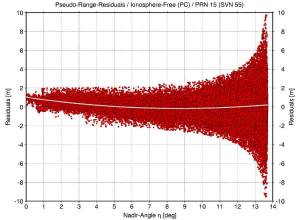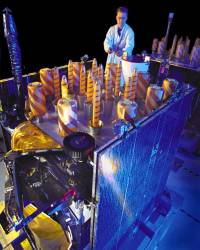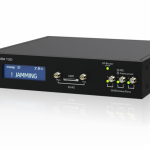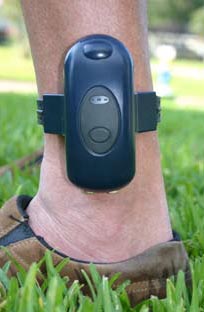 Block IIR Satellite L-Band Transmitter Array of 12 Helical Antennas. Lockheed Martin photo.
Block IIR Satellite L-Band Transmitter Array of 12 Helical Antennas. Lockheed Martin photo.After GPS Wing engineers and contractors figure out how to solve the elevation-dependent signal anomalies on the latest GPS satellite — Space Vehicle Number 49 (SVN49), they may want to take a look at another nine Block IIR and IIR-M spacecraft that European scientists say exhibit similar, but less severe, behavior.
In an article that will appear in the July/August issue of Inside GNSS, Tim Springer and Florian Dilssner, GNSS engineers in the Navigation Support Office of the European Space Operations Center (ESOC), described the effects of the anomaly as well as the U.S. Air Force’s initial attempts to solve the problem by altering the broadcast satellite orbital positions and time. A version of the article was posted June 25 on the magazine’s website.
After GPS Wing engineers and contractors figure out how to solve the elevation-dependent signal anomalies on the latest GPS satellite — Space Vehicle Number 49 (SVN49), they may want to take a look at another nine Block IIR and IIR-M spacecraft that European scientists say exhibit similar, but less severe, behavior.
In an article that will appear in the July/August issue of Inside GNSS, Tim Springer and Florian Dilssner, GNSS engineers in the Navigation Support Office of the European Space Operations Center (ESOC), described the effects of the anomaly as well as the U.S. Air Force’s initial attempts to solve the problem by altering the broadcast satellite orbital positions and time. A version of the article was posted June 25 on the magazine’s website.
The cause of the SVN49 anomaly, which appears most strongly on signals transmitted on the L1 frequency, is now understood, as well as the reason why certain receivers do not “see” the anomaly. The effect is caused by signal reflections coming from a special auxiliary port (designated J2) that is used to feed the L5 signal to the satellite’s antenna array.
These reflections cause a secondary-path signal with a delay of approximately 30 nanoseconds, which has the appearance of a multipath error. Ground receivers with advanced multipath mitigation techniques are not as sensitive to the anomaly — or at least much less so.
In these discussions the ESOC engineers learned that GPS SVN55 and, most likely, other Block IIR and IIR-M satellites carry some electronic equipment connected to the same auxiliary port as used for the L5 signals on SVN49. (Independent sources have confirmed to Inside GNSS that a classified payload has been connected to the J2 port on several satellites. However, unlike SVN49, these classified packages include a component designed to negate or dampen the secondary-path signal.)
Assuming that any electronic signal connected to this auxiliary port would likely cause a similar kind of signal reflection — and associated disturbance in pseudorange accuracies as observed on SVN49, Springer and Dilsner took a closer look at the residuals of all GNSS satellites used in ESOC’s routine processing of observations for the International GNSS Service (IGS).
Their analysis revealed that SVN49-like L1 pseudorange anomalies are indeed present on several GPS Block IIR and IIR-M satellites, but these anomalies are much smaller in size. The most conspicuous residuals are observed for SVN55 and SVN43. The accompanying figure illustrates the anomaly for SVN55.
The figure shows an anomaly for SVN55 at approximately the one-meter level, which is much smaller than the four-meter level of SVN49; however, the nadir-dependent (from the perspective of the satellite) pattern is very similar as the one observed for SVN49. Because of the very small size of the anomaly this effect had not been noticed until now.
The one-meter bias for a nadir angle of zero degrees (i.e., an observation in the zenith of the Earth-fixed observer) is easily overlooked in any statistical analysis, given the strong increase of the noise of the observations with increasing nadir angle. The anomaly of SVN43 looks very similar, according to Springer and Dilssner.
Furthermore, they say that anomalies seem to be present on signals from SVNs 41, 44, 58, 59, 60, and 61. So, of the 19 Block IIR and IIR-M satellites that the ESOC engineers analyzed, 9 show an anomaly at the one-meter level in their pseudorange observations.
At the same time none of the 11 Block IIA satellites or the 18 active Russian GLONASS satellites that they analyzed shows any sign of anomalies in the pseudorange observations. “We therefore suspect that those Block IIR and IIR-M satellites that show a pseudorange anomaly have some kind of electronic equipment connected to their auxiliary port,” said Springer and Dilssner.
The GPS Wing is currently gathering information from manufacturers and user communities regarding the effect of the SVN49 anomaly on a wide range of GPS products and applications. The research will be used to reach a decision on whether or not to set the satellite healthy and, if set healthy, what to do to mitigate the signal anomaly prior to setting it healthy.






